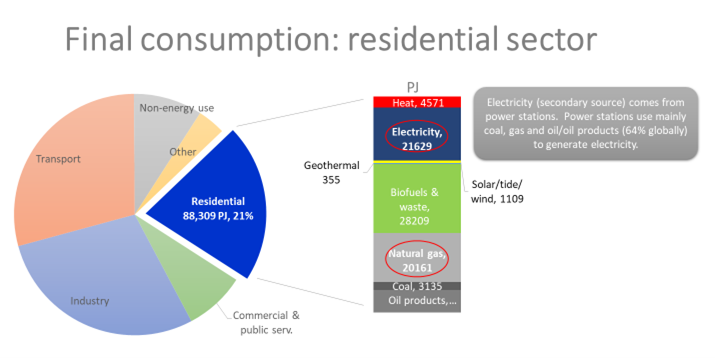Global carbon emissions by source, by Alisa Singer www.environmentalgraphiti.org. Protegoterra has permission to use the image on the website. If you would like to download/distribute/use/reproduce the image, please address your request to the artist at www.environmentalgraphiti.org to obtain permission.
Welcome back, readers! In my past articles, we saw that CO2 is the key greenhouse gas driving climate change and that it comes mainly from the burning of fossil fuels. We saw that we burn fossil fuels to meet our energy demand. We continued our journey and analyzed our energy supply and consumption, including where we use that energy (end-use sectors).
Today we start talking about solutions and what we can do to reduce our energy-related emissions. I want to start with the residential sector, which includes our houses/apartments.
Energy consumption in the residential sector
Let’s look at the chart below: it shows the global energy consumption for the residential sector. We can see the sources in the residential sector: around half of our consumption is electricity plus natural gas (the sum of the red circles in the bar). Therefore we know where to start.

First, we need to decarbonize the electricity. We do this by adding more renewable energy sources to produce electricity.
Second, we need to substitute natural gas consumption with electricity (e.g., electrifying our heating), and that electricity must be generated from renewable energy sources.
Let’s see how we can be part of the solution
I assume that you have done your share in raising awareness about the climate crisis (e.g., talked with friends and family), as well as you have done all you could do in terms of energy efficiency (e.g., changed your old lightbulbs)– so you are already saving money.
What can you do today to reduce your energy-related emissions?
1. Install Solar Panels
If you can, install solar panels to produce your electricity (solar PV). In this way, you are generating electricity from the sun and moving away from fossil fuels (here in NSW, Australia, around 80% of our electricity was generated mainly by fossil fuels in 2019). You can also install solar panels to heat your water (solar thermal). Costs vary depending on where you live (e.g., government incentives, if you sell back excess electricity produced) and differ from one house to another.
2. Switch to renewable energy sources within your energy provider
If you live in an apartment or own your roof but can’t buy or lease solar panels, you can switch to renewable energy sources within your local energy provider or move to a provider that offers you a greener option.
It is only one call away, and you can make a real difference. Let me explain.
How does it work?
Your electricity provider might offer you to go green by choosing an amount from 10 to 100% of your electricity consumption. When you decide to switch to renewable energy, your provider will purchase government-accredited renewable energy certificates on your behalf. This clean energy does not feed directly into your power supply but is added to the electricity grid. This means that you are increasing the amount of renewable energy in the grid. You decided that you don’t want your electricity produced from fossil fuels.
Who pays for it? You pay for it. Usually, the cost starts from 4/5 cents every kWh (Kilowatt hour) in addition to your electricity consumption charges (in NSW, the average usage rate was 23.29 cents/kWh @July 2021). Costs can vary between providers; check how much you currently pay from your bills.
This is how we act to reduce our energy-related emissions: we add more and more renewable energy to the grid to power our houses/apartments (and you can do the same if you are a small business, school, shopping center, etc. or, for leading companies, join the RE100 initiative and set a goal to achieve 100% of renewable electricity – but this is another sector and will talk about that in other articles).
Unfortunately, the solutions above (1 & 2) might not always be available or suitable for you. However, you can still make a difference and send a powerful signal to the market with the third option – going carbon neutral (offsetting/matching your emissions).
3. Become carbon neutral
You can decide to opt in to become carbon neutral. It is an option that you can add to your current energy plans. Go to your energy provider’s website and check the carbon-neutral option it offers (they can call it carbon neutral, offsetting, or matching your emissions).
How does it work?
When you go carbon neutral, your energy provider calculates the emissions associated with your household’s energy use and purchase corresponding carbon offsets (these are certificates from climate active projects), making your home energy use carbon neutral.
Who pays for it?
Some providers offer it for free, and others may ask you 0.5$ or 1$ per week in addition to your energy bill (check the cost with your provider or choose one that offers this solution for free).
Now we could debate the quality of the carbon credits purchased, but this is not the point here; bear with me, and I will explain why. You have opted in to become carbon neutral (for free, or at a minimum cost for you), and your operator now needs to buy a number of credits equivalent to your CO2 emissions (1 certificate=1 ton CO2). Now, you tell your friends and neighbors to do the same. As more and more people opt-in, there will be a point where the operator will have to pay so much for carbon credits that it might be worth considering financing new renewable energy projects – this is what we want!
We collectively push for a change, and the operator takes the opportunity.
As customers, we have this power in the choices we make every day. Let’s harness this power and ignite the change.
The most important thing you can do is to switch to renewable energy. Let’s do it today and leave our kids a livable earth.
Thanks for reading!
If you enjoyed this article, subscribe to Protegoterra’s newsletter.

